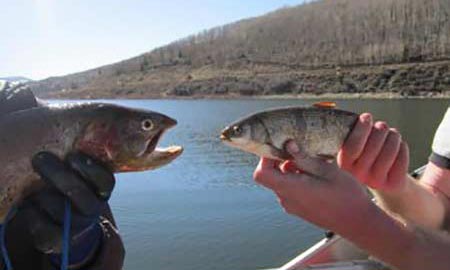Trout vs. chub
Determining the effect Utah chubs have on Scofield trout populations
By Shauna Leavitt
Guest contributor
Utah Division of Wildlife Resources (DWR) and Utah State University (USU) are working together to determine the effect that the Utah chub has on trout populations on Scofield.

Graduate student Lisa Winters holds a mature tiger trout. Trout grow quickly when they are on a Utah chub diet.
Scofield Reservoir (a 2,815-acre man-made lake), northwest of Price, Utah has, "Historically [been] the most important trout fishery in Utah's southeastern region " says Dr. Phaedra Budy with the Quinney College of Natural Resources.
The trout (tiger, cutthroat and rainbow) now share the reservoir with the unwelcome Utah chub that has made the reservoir its home. The reservoir is thick with chub: carp-like fish that mature quickly and are extremely prolific. In fact, chub currently outnumber trout in Scofield Reservoir nine to one.
The main questions for fisheries managers are whether or not the growing population of chub will compete with sport fish for food and/or space, as has been observed elsewhere, or whether chub can be effectively controlled by trout populations. In an effort to answer these questions, DWR commissioned a multi-year research project with Dr. Phaedra Budy's Fish Ecology Lab in the Department of Watershed Sciences (Quinney College of Natural Resources) at USU to determine the predator and forage relationships between the trout and chub.

The competitors: trout vs. Utah chub in Scofield Reservoir.
Based on the USU research, one observed benefit of the chub is the impact it has on the growth of trout that eat it. After stocked tiger and cutthroat trout reach a certain size (usually a year after being stocked in the reservoir) they switch to a diet of fish and begin eating the chub. Once they begin eating chub, trout grow extremely rapidly, said Gary Thiede, fishery biologist in the Department of Watershed Sciences.
The chub may, therefore, be beneficial to the reservoir's ecosystem if the numbers can be controlled. DWR managers hope to use the results of the USU research to develop the best management plan for trout and chub populations in Scofield Reservoir.
DWR managers hope to use the results of the research to develop the best management plan for trout and chub populations in Scofield Reservoir.















